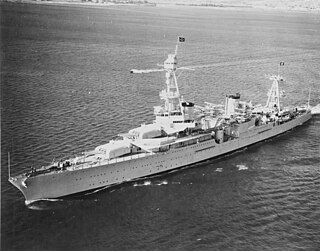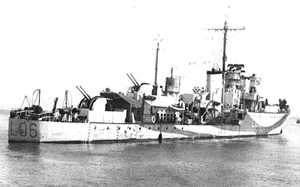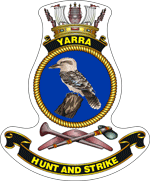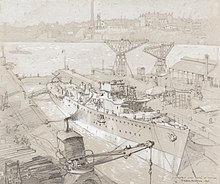
USS Houston (CL/CA-30), was a Northampton-class cruiser of the United States Navy. She was the second Navy ship to bear the name "Houston".

HMAS Nestor (G02) was an N-class destroyer of the Royal Australian Navy (RAN). Built in Scotland, Nestor was commissioned in February 1941; although manned by Australians and commissioned as an Australian warship, she remained the property of the Royal Navy.

HMAS Quiberon (G81/D20/D281/F03) was a Q-class destroyer of the Royal Australian Navy (RAN). Although built for the Royal Navy and remaining British property until 1950, Quiberon was one of two Q-class destroyers commissioned into the RAN during World War II. She was passed into full RAN ownership in 1950, and converted into an anti-submarine frigate.
Four ships of the Royal Australian Navy (RAN) have been named HMAS Yarra after the Yarra River in Victoria.

HMAS Burnie (J198/B238/A112), named for the port city of Burnie, Tasmania, was one of 60 Bathurst-class corvettes constructed during World War II and one of 20 built for the Admiralty but manned by personnel of and commissioned into the Royal Australian Navy (RAN).

HMAS Deloraine (J232/M232), named for the town of Deloraine, Tasmania, was one of 60 Bathurst-class corvettes constructed during World War II, and one of 36 initially manned and commissioned solely by the Royal Australian Navy (RAN). In January 1942 she evaded an attack by the Japanese submarine I-124 north-west of Darwin and was jointly credited with the submarine's sinking after inflicting the initial damage. She was present at the bombing of Darwin and survived unscathed.

The Battle of the Java Sea was a decisive naval battle of the Pacific campaign of World War II.

HMAS Swan (U74/F74/A427), named for the Swan River, was a Grimsby-class sloop of the Royal Australian Navy (RAN) that served during World War II.

HMAS Hobart was a modified Leander-class light cruiser which served in the Royal Australian Navy (RAN) during World War II. Originally constructed for the Royal Navy as HMS Apollo, the ship entered service in 1936, and was sold to Australia two years later. During the war, Hobart was involved in the evacuation of British Somaliland in 1940, fought at the Battle of the Coral Sea and supported the amphibious landings at Guadalcanal and Tulagi in 1942. She was torpedoed by a Japanese submarine in 1943, then returned to service in 1945 and supported the landings at Tarakan, Wewak, Brunei, and Balikpapan. Hobart was placed in reserve in 1947, but plans to modernise her and return her to service as an aircraft carrier escort, training ship, or guided missile ship were not followed through. The cruiser was sold for scrapping in 1962.

HMAS Australia (I84/D84/C01) was a County-class heavy cruiser of the Royal Australian Navy (RAN). One of two Kent-subclass ships ordered for the RAN in 1924, Australia was laid down in Scotland in 1925, and entered service in 1928. Apart from an exchange deployment to the Mediterranean from 1934 to 1936, during which she became involved in the planned British response to the Abyssinia Crisis, Australia operated in local and South-West Pacific waters until World War II began.

HMAS Perth was one of three modified Leander-class light cruisers used by the Royal Australian Navy (RAN) during the early part of World War II. She was built for the Royal Navy (RN) in the mid-1930s and was commissioned as HMS Amphion in 1936. The ship spent the next several years as flagship of the Commander-in-Chief, Africa before she was transferred to the RAN in 1939 and renamed as HMAS Perth.

HMAS Canberra (I33/D33), named after the Australian capital city of Canberra, was a Royal Australian Navy (RAN) heavy cruiser of the Kent sub-class of County-class cruisers. Constructed in Scotland during the mid-1920s, the ship was commissioned in 1928, and spent the first part of her career primarily operating in Australian waters, with some deployments to the China Station.

The first HMAS Bendigo (J187/B237/A111) was a Bathurst-class minesweeper, a group commonly known as corvettes and including escort and patrol duties along with minesweeping.

The history of the Royal Australian Navy traces the development of the Royal Australian Navy (RAN) from the colonisation of Australia by the British in 1788. Until 1859, vessels of the Royal Navy made frequent trips to the new colonies. In 1859, the Australia Squadron was formed as a separate squadron and remained in Australia until 1913. Until Federation, five of the six Australian colonies operated their own colonial naval force, which formed on 1 March 1901 the Australian Navy's (AN) Commonwealth Naval Force which received Royal patronage in July 1911 and was from that time referred to as Royal Australian Navy (RAN). On 4 October 1913 the new replacement fleet for the foundation fleet of 1901 steamed through Sydney Heads for the first time.

HMAS Wollongong (J172), named for the city of Wollongong, New South Wales, was one of 60 Bathurst-class corvettes constructed during World War II and one of 20 built for the Admiralty but manned by personnel of and commissioned into the Royal Australian Navy (RAN).

Robert William Rankin was a Royal Australian Navy officer who was killed in action during the Second World War. He is one of six people to have had a Collins class submarine named after him.

Task Force 44 was an Allied naval task force during the Pacific Campaign of World War II. The task force consisted of warships from the United States Navy and the Royal Australian Navy (RAN). It was generally assigned as a striking force to defend northeast Australia and the surrounding area from any attacks by Axis forces, particularly from the Empire of Japan.

HMS Avon Vale(pennant number L06) was an escort destroyer of the Hunt Type II class. The Royal Navy ordered Avon Vale's construction three days after the outbreak of the Second World War. John Brown Shipbuilding & Engineering Company Ltd laid down her keel at their Clydebank yard on 12 February 1940, as Admiralty Job Number J1569. After a successful Warship Week national savings campaign in February 1942, Avon Vale was adopted by the civil community of Trowbridge, Wiltshire.
Vice Admiral Sir Wilfred Hastings "Arch" Harrington was a senior officer in the Royal Australian Navy (RAN), who served as First Naval Member and Chief of the Naval Staff from 1962 to 1965.

The second HMS Exmoor (L08), ex-HMS Burton, was a Hunt-class destroyer of the Royal Navy in commission from 1941 to 1945. She was a member of the second subgroup of the class, and saw service during much of World War II. She later served in the Royal Danish Navy as HDMS Valdemar Sejr.




















